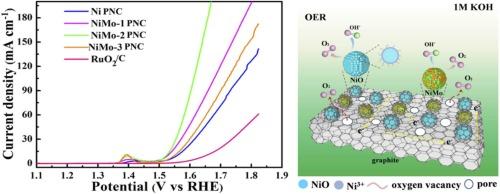Graphite encapsulated high active nickel-molybdenum/nickel oxide porous nanosheet composites as enhanced oxygen evolution reaction electrocatalysts
IF 6.3
2区 材料科学
Q2 CHEMISTRY, PHYSICAL
引用次数: 0
Abstract
Electrocatalytic water splitting for hydrogen production is one of the effective solutions to alleviate energy crisis and reduce carbon emission. The large overpotential and the high sluggish reaction kinetics of the oxygen evolution reaction (OER) at the anode seriously restrain the overall efficiency of water splitting. Nickel-based materials are widely studied in alkaline electrolytes attributed to the low cost and good stability. However, the insufficient exposure of active sites and inferior actual catalytic activity hinder the further enhancement of its OER activity and stability. In the present work, a morphological and microstructural synergistic regulation strategy is developed to prepare NiMo/NiO porous nanosheet composites (PNC) by using Mo element doped Ni metal-organic frameworks (MOFs) as precursors. The nanocrystals of NiMo alloy and NiO are subsequently encapsulated by ultrathin graphite layers with abundant Ni3 + oxides and oxygen vacancy formed on the surface of NiO. Electrochemical studies have revealed that NiMo-2 PNC exhibits excellent oxygen evolution reaction (OER) electrocatalytic activity. The corresponding overpotentials of NiMo-2 PNC are only 292 mV and 311 mV at 10 and 20 mA cm−2, respectively, along with a lower Tafel slope and good stability. The remarkable catalytic performance is primarily attributed to the synergistic effects of the specific morphology, Mo element, Ni3+ and oxygen vacancy defects, which can increase the number of exposed effective active sites, regulate the electronic structure of Ni metal and optimize the adsorption energy of NiO for the intermediates of OER, leading to the improved catalytic activity and electron transport kinetics.

石墨包封高活性镍钼/氧化镍多孔纳米复合材料作为增强型析氧反应电催化剂
电催化水裂解制氢是缓解能源危机、减少碳排放的有效解决方案之一。阳极析氧反应(OER)的过电位大,反应动力学慢,严重制约了水分解的整体效率。镍基材料因其成本低、稳定性好而在碱性电解质中得到广泛研究。然而,活性位点暴露不足和实际催化活性较差阻碍了其OER活性和稳定性的进一步提高。本文以Mo元素掺杂的Ni金属有机骨架(MOFs)为前驱体,研究了一种形态和微观结构协同调控策略,制备了NiMo/NiO多孔纳米片复合材料(PNC)。NiO合金和NiO纳米晶随后被超薄石墨层包裹,在NiO表面形成丰富的Ni3+氧化物和氧空位。电化学研究表明,NiMo-2 PNC具有优异的析氧反应(OER)电催化活性。NiMo-2 PNC在10和20 mA cm-2下的过电位分别为292 mV和311 mV, Tafel斜率较低,稳定性好。其显著的催化性能主要是由于特定形貌、Mo元素、Ni3+和氧空位缺陷的协同作用,增加了暴露的有效活性位点数量,调节了Ni金属的电子结构,优化了NiO对OER中间体的吸附能,从而提高了催化活性和电子传递动力学。
本文章由计算机程序翻译,如有差异,请以英文原文为准。
求助全文
约1分钟内获得全文
求助全文
来源期刊

Journal of Alloys and Compounds
工程技术-材料科学:综合
CiteScore
11.10
自引率
14.50%
发文量
5146
审稿时长
67 days
期刊介绍:
The Journal of Alloys and Compounds is intended to serve as an international medium for the publication of work on solid materials comprising compounds as well as alloys. Its great strength lies in the diversity of discipline which it encompasses, drawing together results from materials science, solid-state chemistry and physics.
 求助内容:
求助内容: 应助结果提醒方式:
应助结果提醒方式:


